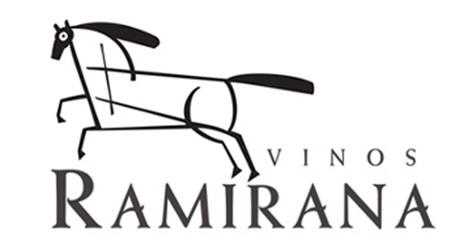Ramirana wines come from a company known as Viña Ventisquero which began making wine only thirteen years ago. By Chilean standards, where wine-making goes back generations, it’s pretty much the new kid on the block. Even so, in a remarkably short time, Ventisquero has become a big name internationally and produces a range of splendid award-winning wines. The company also makes the Yali range as well as a selection of fine wines under the original Ventisquero label. And talking of labels, this Ramirana one shows what looks like a cave-drawing of a flying horse. Well, I think the horse is flying. It might of course just be prancing up and down. But it’s definitely a horse and even the dogs agree.
I don’t know whether you’ve come across those people who like to say that they find Chardonnay boring. I have, and I suspect that they haven’t tasted very many of them because so many different styles of Chardonnay exist. Of course, we all know where the very best, most elegant, most revered and most expensive Chardonnays come from, don’t we? Yes, they come from villages among the rolling hills of Burgundy and it’s almost the only white grape grown there. The wines can cost an arm and a leg and sometimes several of each.

In this country, the starting price for a white Burgundy is around Bt. 1,400 and the price reaches staggering heights for really top-class examples. Few people in my soi can afford to fork out a couple of thousand baht every night for a Burgundy, but fortunately there are also some excellent Chardonnays from Chile. They are often fruitier and richer than their French cousins. That doesn’t mean to say that they’re better of course; they’re just different.
Ramirana Chardonnay 2010 (white), Chile (Bt. 429 @ Villa)
This is a typical Chilean Chardy, with a honeyed aroma and a slightly creamy texture. It’s a pale, straw-gold with hints of green. Swirl it around in the glass and you’ll get a lovely sweet floral aroma and if you’re observant, you’ll notice the rich syrupy legs too. The smell of pineapple will probably come out first, followed by a pleasing aroma of ripe bananas, honey, hints of melon and a dash of citrus.
The mouth-feel is superb, a lovely soft, creamy texture yet a perfect fruity dryness with an attractive gentle touch of acidity. This is an excellent well-balanced and fruit-forward wine, medium-bodied and quite rich and complex in flavour. It has 13% alcohol content but I’d be quite happy to drink this on its own. Even so, it would make a good partner for chicken or grilled fish dishes, cheese quiche or even mild curries and would go well with medium-fat cheeses like Emmenthal or Gruyère. Of course, as with most white wines you’ll need to drink this fairly cold and in any case, it will warm all too quickly. Just serve it straight out of the fridge.
Ramirana Cabernet Sauvignon 2011 (red), Chile (Bt. 429 @ Villa)
This is a ruby red wine which also reveals its “legs” when you swirl it around. Mind you, I’d probably do the same. But don’t rush this one, because it needs time for the aromas to develop. If you happen to have a decanter or wine jug, now’s the time to dig it out. I use a decanter for almost every wine and you’d be surprised what a difference it makes to the aroma and flavour. There’s no need to pour the wine daintily as though it were liquid gold; let it slosh around a bit, so that it really gets some air contact.
This wine has that typical Cabernet aroma of black cherries and in the background you might detect ripe raspberries and earthy plums. I thought there might even be a hint of orange peel too. The wine is very dry with a cloak of soft ripe tannins and plenty of fruit on the palate. The texture is soft and seductive, and the taste really seems to blossom in the mouth – one of the signs of a well-made wine. There’s an attractive long dry finish with more hints of tannin. The alcohol content is getting on for 14% which is pretty much at the top of the tree for table wines. Nonetheless, this is a lovely smooth, classy wine that is a pleasure to drink on its own. For food partners, red meat or assertive cheeses would work well. Serve it on the cool side, of course unless you always eat your meals in air-conditioned comfort.
Ramirana Merlot 2012 (red), Chile (Bt. 429 @ Villa)
Wine beginners sometimes think that Cabernet Sauvignon and Merlot are poles apart, but they are actually very similar in terms of colour, aroma and flavour. They’re almost the opposite side of the same coin and easy to confuse. Both grapes hail from the Bordeaux region of France, where they’re nearly always blended together, often with Cabernet Franc and Petit Verdot.
So what’s the difference between Cabernet and Merlot? Well, Merlot tends to have a lighter body and softer tannins. It often comes with a sappy, earthy aroma of herbs, olives, red berries and plums. These smells also come through on the taste and sometimes there are cherry or even chocolate-like flavours. In contrast, Cabernet usually has dusty aromas of black fruit and black cherries. It usually has a bit more backbone and tannic strength, with flavours of blackcurrant, plum and spice. But of course, these are terribly vague generalisations because aromas and tastes vary enormously depending on the skills and intentions of the winemaker. They’re also influenced by the country and region of origin, the climate and the soil, or as the French would say, the terroir, a convenient word that combines everything that influences the growth of the grape.
This wine is a deep, rich red with hints of purple. It has a gorgeous concentrated aroma of sharp dark fruits and black cherry but the smell is dominated by herbs and olives with a delicate touch of fresh mint. Despite being completely dry, this medium-bodied wine has a surprisingly soft, silky mouth-feel with a pleasing foundation of gentle, ripe tannins. The herbs come through on the palate too, along with that woodland earthy quality that you sometimes find in good Merlot. The finish is surprisingly long and dry with reminders of dark fruit and brambles. This is a deeply satisfying, brooding Merlot which really holds the attention and is lovely to enjoy on its own. With food, I’d suggest dishes which are richly flavoured such as grilled chops, steak, roast rack of lamb or roast game.
Well then, here’s an embarrassment. Just as I was writing that last bit, someone pointed out that the horse on the label cannot possibly be flying, because it hasn’t got any wings. I must confess that this rather obvious fact had escaped me. So I’m terribly sorry to disappoint you, but the horse isn’t flying after all. However, there’s a slight problem because at this late stage, I really can’t change the title. So, if it’s not too much trouble, could you just get a pen and neatly cross out the word “flying” in the heading? If you can achieve this without making a dreadful mess, so much the better. I’d be terribly grateful, honestly.




